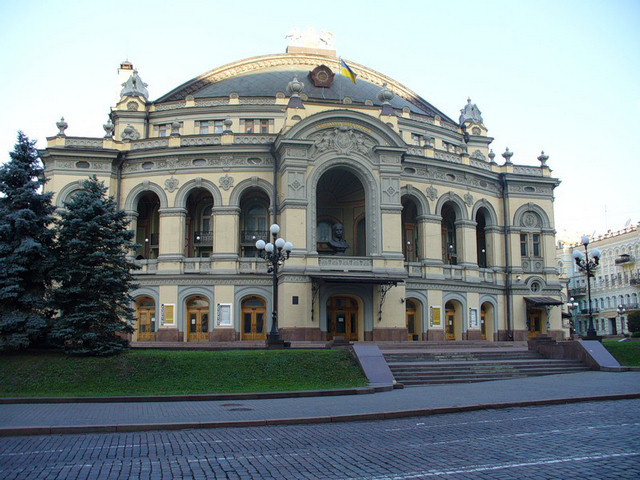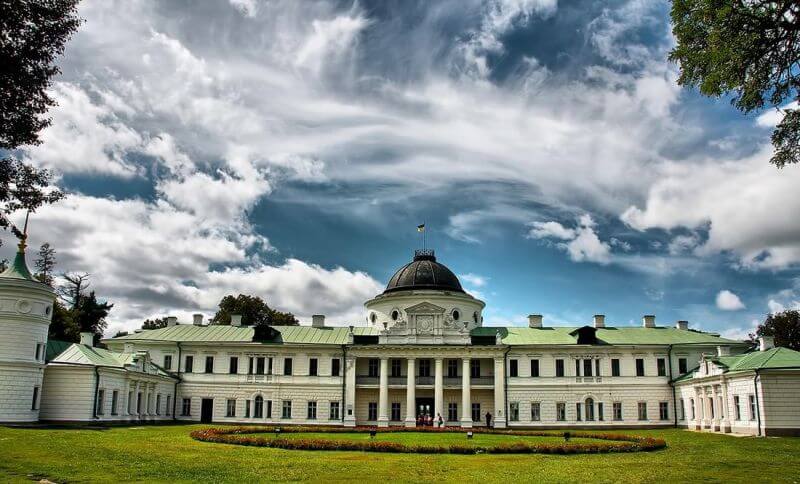Taras Shevchenko National Opera of Ukraine (Kyiv)
The appearance of this wonderful building was preceded by a tragic event: in February 1896, after the morning performance of the opera “Eugene Onegin”, a fire broke out in one of the dressing rooms. The fire spread quickly, and within a few hours, only black walls remained from the City Theater, built in 1856 according to the project of the architect Ivan Strom. The music library, costumes and scenery of many performances were destroyed in the fire. The people of Kyiv demanded to build a new building as soon as possible. After heated debates and disputes, the city council decided to hold an international competition for the Kyiv Opera project. Three dozen architects from the Russian Empire, Germany, France and Italy took part in it. The project of the chief architect of the directorate of imperial theaters, academician Viktor Shreter, won the victory. And the theater was built in 1898-1901 under the leadership of the famous Kyiv architect Volodymyr Nikolaev. The new theater impressed the imagination of contemporaries – the semi-oval facade richly decorated with stucco, strict, deep arches raise the strong building to a height. Two muses spread their wings above the central entrance. And inside – Venetian mirrors, gilding, bronze, patterned stucco walls and ceiling, marble staircase and floor mosaic, queen-chandelier in the center of the lace ceiling. An allegorical composition has been created on the roof: heraldic griffins hold a lyre in their paws as a symbol of musical art.

Palace of Sighs (Kyiv)
Neoclassicism, Neo-Romanesque style, Neo-Baroque, Constructivism – the outstanding Ukrainian architect Pavlo Alyoshin worked in all possible architectural styles of the first half of the 20th century. Many residents of Kyiv and guests of the city stopped their admiring gaze at the buildings of the Palace of Sighs (another name is the “Arab House”) in the neo-Romanesque style, which stands on the corner of Pylypa Orlyk and Shovkovychna streets, but not everyone knows the history of its creation and the origin of the name. At one time, the Kyiv official Mykola Kovalevsky ordered Alyosha an estate, which later got its name because the customer had to sigh a lot during construction. The tour guides say that Kovalevsky sighed because of his great love for his wife Hanna, for whom, in fact, he designed the house. However, these sufferings could also be for purely pragmatic reasons: during the construction period (1911-1913), the building estimate exceeded the original two and a half times! The customer even wrote to the architect that Alyoshin’s artistic fantasies prevented him from eating and sleeping. The house was still built, and Mykola Kovalevsky settled in it with his beloved wife. In honor of the couple’s love, the house even had a room decorated in the form of a compartment car – after all, the Kovalevskis met on a train. And they also say that the cat’s head on the wall of the Kovalevsky estate is a hidden portrait of the architect himself.
Potocki Palace (Lviv)
The Palace of Counts of Potocki is a vivid example of mature historicism architecture, one of the most interesting architectural monuments of Lviv. The palace is the prototype of the so-called “Entre cour et jardin” residences of King Louis XIV, whose style is defined as “baroque classicism”, where clear planning is combined with rich exterior decoration. On the plan, it has a rectangular shape with minor side elevations. The Potocki Palace was designed in 1880 by the French architect Louis Alphonse René Duvernier on the order of Count Alfred II Potocki, a great connoisseur of French architecture. In the same year, a union of Lviv architects Ludvig Baldwin-Ramult, Juliusz Tsybulskyi, Petr Garasimovych and Leonard Marconi began to build it. Alfred II did not live to see the completion of the works, his son Roman Pototsky completed the construction of the palace in 1890. The last owner, Alfred III (1886–1958), left the palace after the Soviet occupation of Lviv in 1939 and never returned.
At the time of Ukraine’s independence, the possibility of arranging the residence of the President of Ukraine in Lviv was discussed in the palace. But in 2002, the city transferred the Potocki Palace to the Lviv Art Gallery. After the completion of the restoration, on February 14, 2007, the Museum of European Art of the XIV-XVIII centuries was opened in the Palace – the Gallery department.
Sokyry Palace (Chernihiv Region)
The beautiful estate of the ancient Ukrainian family of the Galagans, surrounded by a luxurious English landscape park with lakes and sculptures in Sokyryntsy, Chernihiv region, is a landmark of 19th century garden and park art.
For several centuries, Sokyryntsi was owned by the Galagan family. There were traitors and philanthropists among them, but the majestic empire-style palace with 60 rooms was built here by Prylut Colonel Pavlo Galagan. The founder of the manor was an educated person and sincerely loved architecture, so here, in Sokyryntsy, architects implemented his idea. The palace was built in 1823-1829. The well-known Ukrainian architect Pavlo Dubrovsky was involved in the development. The sumptuously decorated and artistically decorated complex was one of the richest and most beautiful estates of its time. And the arrangement of the park zone stretched for a whole century, that is, for the entire time that the manor had the status of a family. The highlight of the park is the Shevchenkiv sycamore, the oldest tree in the garden complex. It is believed that it was under this sycamore that the famous words of the poet were written: “Water flows from under the sycamore, in a ravine to the valley…”. Today, the Sokyryna Professional Agrarian Lyceum and the historical and ethnographic room-museum of O. Veresai, a resident of these places, are located in the palace.

Railway station in Kozyatyn (Vinnytsia region)
A unique architectural monument of the city of Kozyatyn is the railway station building in the form of a majestic steamship, surrounded on both sides by rail networks. The railway station of the Kozyatyn station, built in 1888-1889 according to the project of the outstanding architect Valerian Kulikovsky, is considered one of the oldest and most original on the territory of Ukraine. The station was built by a young engineer, and in the future, the famous Ukrainian architect Oleksandr Kobelev – a bright figure in the history of Ukrainian architecture. The godson of Emperor Alexander II, he married a Greek noblewoman and, it seems, escaped Stalin’s repressions only by a miracle. Oleksandr Kobelev is also the author of the railway station in Korosten, and he designed the land bank in Poltava. Kyiv is also decorated with his creations – in particular, the building of the National Bank of Ukraine.
Poltava Local Lore Museum (Poltava)
Vasyl Krychevskyi is a unique Ukrainian artist, architect and graphic artist, who in 1918 created the project of the Ukrainian state coat of arms. It was according to his architectural project that the Poltava Provincial Zemstvo was built, the building of which now houses the Poltava Local History Museum named after Vasyl Krychevsky and is considered a real pearl of the city of Poltava. The architect used all types of art in the exterior and interior of the building: ceramics, carvings, textiles, wall paintings. The zemstvo building was designed in such a way that it began to make an impression even from a distance. According to the idea of a Kharkiv architect, watered blue-green tiles were laid on the roof in a mosaic pattern so that it played with colors in the sun. Local historians say that Vasyl Krychevsky watched the performance of this work from the roof of another building and gave instructions to the workers with the help of flags. Thousands of ceramic tiles were made by Poltava craftsmen to decorate the building. Thanks to this project, Vasyl Krychevsky is called the founder of Ukrainian modernism as an architectural style. Actually, the creators of this building themselves felt like pioneers, because it was not by chance that they wrote on the mortgage board: “We are pioneers of the Ukrainian style. There is no mistake for a fake. We did everything we could. Whoever can, let him do better than us.”
